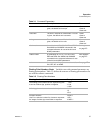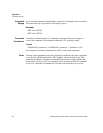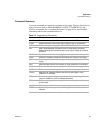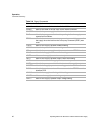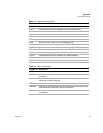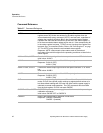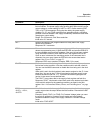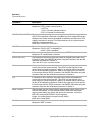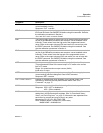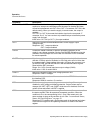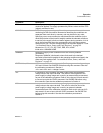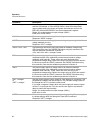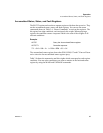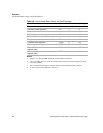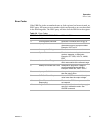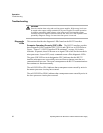
Operation
Command Reference
Release 1.1 45
Command Description
IOUT? Measures and returns the supply’s actual current output using the built-in
current readback circuitry.
Response: IOUT <current>
IRDAT <Ilo>,<Ihi> Calculates and records the slope and offset for readback voltage using
IRLO and IRHI data. Set CMODE ON before using this command. See also
the calibration procedures in Section 4.
<Ilo> and <Ihi> are in <current> format.
IRHI The power supply outputs a current value to an external device connected
as part of the calibration procedure and records a current readback value
internally. These values are at the high end of the programmed current
range. Refer to the output value as IRHI and record it to use as input with
the IRDAT command. Set CMODE ON before using this command. See
also the calibration procedures in Section 4.
IRLO The power supply outputs a current value to an external device connected
as part of the calibration procedure and records a current readback value
internally. These values are at the low end of the programmed current
range. Refer to the output value as IRLO and record it to use as input with
the IRDAT command. Set CMODE ON before using this command. See
also the calibration procedures in Section 4.
ISET <current> Sets the power supply’s output current in amps (default) or in milliamps.
This programmed current is the actual output in CC mode or the current
limit in CV mode.
Range: 0 to model maximum output current (IMAX)
Initial value: 0 amps
ISET? Returns the supply’s present output current setting. Does not apply to
current settings which are being held. See HOLD command.
Response: ISET <current>
LOC <1/ON>,<0/OFF> Enables or disables local mode operation for the power supply. This
command is used with the rear panel Remote switch. See
“LOC
Command” on page 25
.
LOC? Returns the present enabled/disabled setting of local mode operation.
Response: LOC 0 (OFF or disabled) or
LOC 1 (ON or enabled)
MASK <mnemonics> Disables the supply's previously unmasked operating conditions from
setting bits in the fault and status registers. See
“Accumulated Status,
Status, and Fault Registers” on page 49. Mnemonics are separated from
each other by commas and may be sent in any order.
Mnemonics: CV, CC, OV, SD, FOLD, ERR
Note: UNMASK NONE = MASK ALL (Initial value)
MASK NONE = UNMASK ALL



